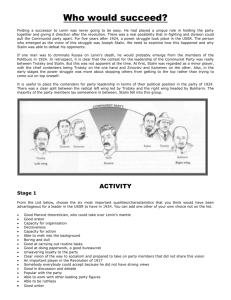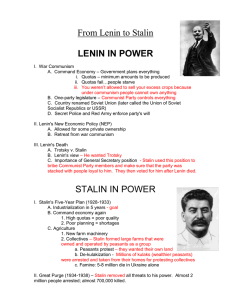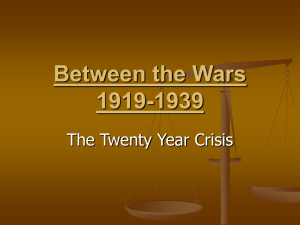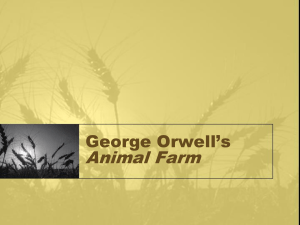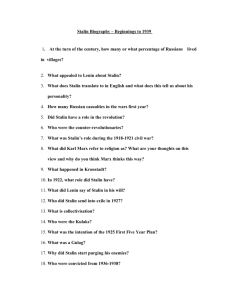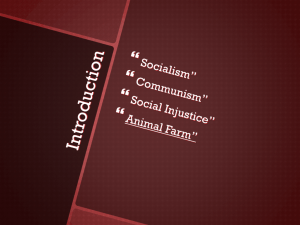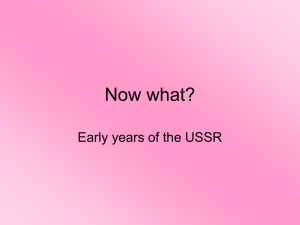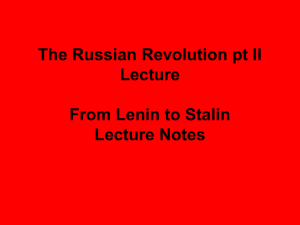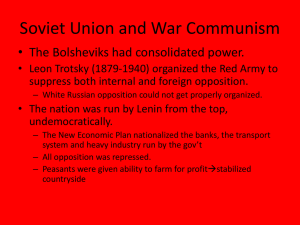Russia after the WWI
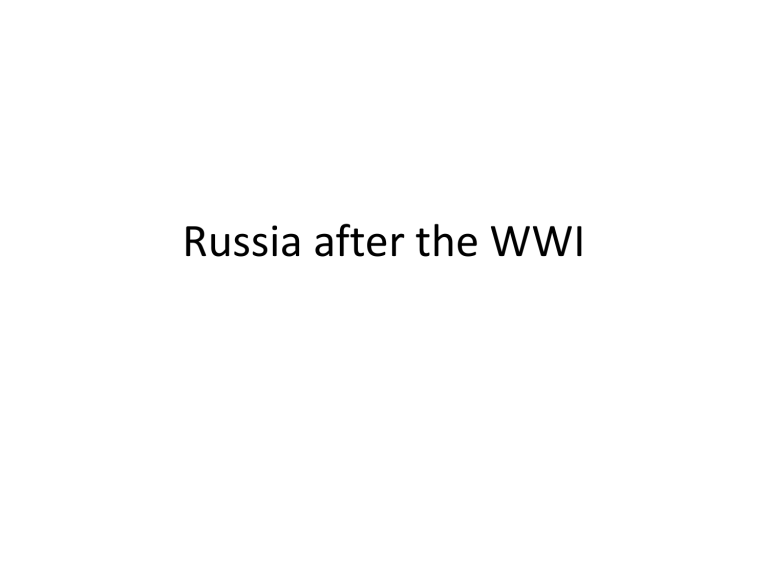
Russia after the WWI
His own real name was V. I. Ulyanov
- Leader of Bolshevicks – elite group of committed revolutionaries.
- He spent most of his life outside of Russia, mostly in western Europe
- Lenin demonstrated a chilling disregard for the sufferings of his fellow countrymen and mercilessly crushed any opposition.
- Organized secret police CHEKA (Chrezvychaynaya
Komissiya)
- His corpse was embalmed and placed in a mausoleum on Moscow's Red Square.
Reforms laws
- separated church and state – wanted to destroy the church
- all religious ceremonies were prohibited, only civil marriage was allowed
- replaced the Julian calendar with the Gregorian and simplified the Cyrilic alphabet
- abolished the titles of nobility
vs
Bolshevicks = Communist
Control the heart of the country, the industry and Red Army
Leon Trotsky
Anti-communist
Control large areas of Russia
Alexander Kolchak, Anton Denikin,
Piotr Wrangel
The Red won, murdered the tsar family in Jekaterinburg and defeated the Whites
-
Major industries including bank were nacionalised
- private trade prohibit
- NEP (New Economic Policy) – March 1921 “ making 1 step back to make 2 steps forward”
- meant that state controlled industry, transportation and foreign trade
- USSR established (Russian Soviet Federated Socialist
Republic) - 1924
- later in 1936 – Stalin constitution of 11 republic, contained a bill of rights
- one party rule – the Communist
- the CHEKA has turned into GPU, OGPU, NKVD (Narodnyj
komissariat vnutrennich del) and finally KGB (Komitet gosudarstvennoy bezopasnosti)
-
His own real name was Lev Davidovich Bronstein
- member of the 'Menshevik' (majority) faction
- own theory of 'permanent revolution’
- despite of disagreemet with Lenin, ha has joined
Bolshevicks
- Several significant position with the communist party, such as foreign commisar, later a war commisar
- One of the crucial figure who kept the bolshevicks regime alive
- Problems with Stalin after the death of Lenin, thrown out of the party because of criticism of Stalin
- Exile in Mexico - murdered
-One of the most powerful and murderous dictators in history
- His own name was J. V Dzhugashvili
- After Lenin's death in 1924, Stalin promoted himself as his political heir
- By the late 1920s, Stalin was effectively the dictator of the Soviet Union.
- forced collectivisation of agriculture, the industry grown up but for a huge cost
- Terror of the 1930s, during which Stalin purged the party of 'enemies of the people', resulting in the execution of thousands and the exile of millions to the gulag system of slave labour camps.
- Stalin formed alliance against Trotsky with Grigori Zinoviev
(head of the Communist International – Comintern), and Lev Kamenev, party leader in Moscow
- With their help, Stalin moved Trotsky away from the position of war commissar, party and what more, from the country, where he was murdered
- After that, the alliance of the Left Bolshevicks, as they were called, had finished
- Stalin had join new alliance of Right Bolshevicks with Nikolai Bukharin (editor of Pravda),
Alexei Rykov (chairman after Lenin) and Mikhail Tomsky (head of the trade unions)
- Zimonev and Kamenev were expelled from the CP, Stalin finished the cooperation with the RB
- 1929 – dictatorship of Stalin
-Five Years Plan – plans were designed to end of NEP, eliminate capitalism and create a socialist economy, promote rapid development of heavy industry and to collectivize agriculture.
- Encouragement of workers by better benefits – the productivity increased into 3 rd place in 1940 behind USA and Germany
- Collectivization – 2 types of farms
- kolchozes = collectives farmes solchozes = stae farms everybody’s land is common, run by a committee peasant paid by regular wages
- Huge demonstration against the collectivization – millions of the rebels had been sent to the labor camps in Siberia
